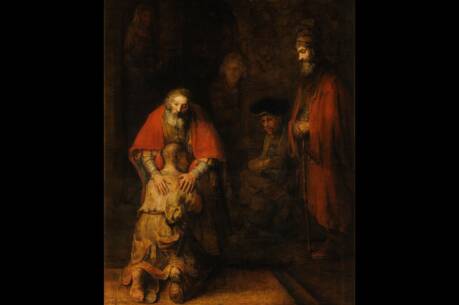Mountaintop Vision
What really happened at the Transfiguration? Each of the Evangelists tells the story slightly differently, with his own theological emphases. Was it a miraculous glimpse of Jesus’ heavenly glory? A temporary unveiling of his divine nature to give hope to his disciples? Or was it a recasting of a resurrection appearance story placed in the middle of the Gospel? These and other theories have long been entertained by biblical scholars.
In Matthew’s version, the radiance of Jesus’ face and clothing and the brightness of the cloud that overshadows the disciples are highlighted. Coming on the heels of Jesus’ teaching that he must suffer and die before being raised up (16:21), the brilliance underscores that Jesus, although executed as a criminal, is righteous. As Jesus had told his disciples, at the end of the age “the righteous will shine like the sun in the kingdom of their father” (13:43). The voice from the cloud likewise reaffirms Jesus’ identity as God’s beloved son, upon whom divine favor rests (as at his baptism, 3:17). The admonition “listen to him” echoes Dt 18:15 and emphasizes that Jesus is the authentic interpreter of the Mosaic law and the prophets. He is not replacing Moses and Elijah but continues the long line of faithful leaders.
The presence of Moses and Elijah recalls their powerful mountaintop experiences of God and hints that similar things happen there to Jesus. On Mount Sinai God spoke to Moses face to face, entrusting to him the commandments that would guide his people to live in faithfulness through the desert days ahead. The glory of God is reflected on Moses’ own face as he returns to the difficult task of leadership (Ex 34:29). Elijah flees to the same mountain when trying to escape the murderous intents of Jezebel. There God speaks to him in a “still, small voice,” giving him the courage to go forward to anoint a new king and Elisha as his successor (1 Kgs 19). Likewise, Jesus is at a turning point in his mission. There are those who seek his life, as well as those who try to live faithfully God’s law that he teaches. On the mountaintop, he is able to see with God’s own vision the way forward in faithfulness.
Jesus’ transforming experience also resonates with that of the Rev. Martin Luther King Jr., who on the night before he was assassinated declared that he had been to the mountaintop and had seen the promised land. He set aside all fear and assured his followers that even if he were killed, as a people they would get to the promised land. God’s transformative love radiates through a face determined to love no matter what the other’s response. As Jesus had taught his disciples from a mountaintop about transforming enmity through love, so King reminded his followers to disarm police forces through loving, nonviolent confrontation and to answer firehoses with “a certain kind of fire that no water could put out.”
King urged his listeners to continue to struggle for justice here and now, not just wait for “long white robes over yonder.” So too, Jesus’ radiant clothes in the Gospel are not simply a glimpse of his own divine status but a vision of the way in which each beloved child of God is to be clothed here and now. King urged his followers to give themselves to this struggle until the end, saying, “Nothing would be more tragic than to stop at this point.” For Jesus, nothing would have been more tragic than to stop with teaching, preaching and healing in the Galilee. To bring transfigured life to completion for all, he continues on toward Jerusalem.
This article also appeared in print, under the headline “Mountaintop Vision,” in the March 14, 2011, issue.








